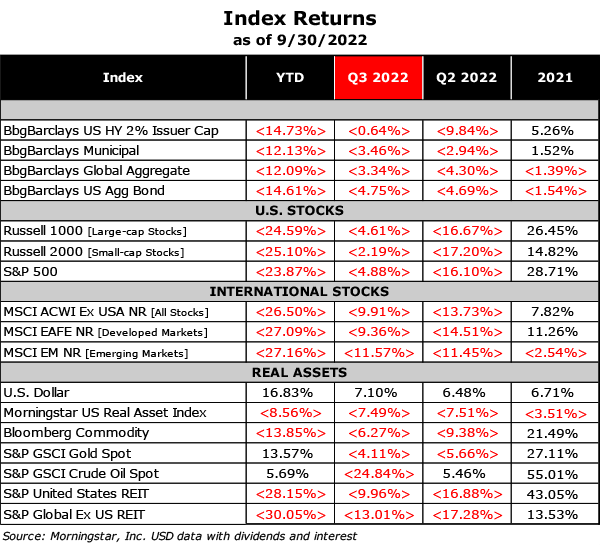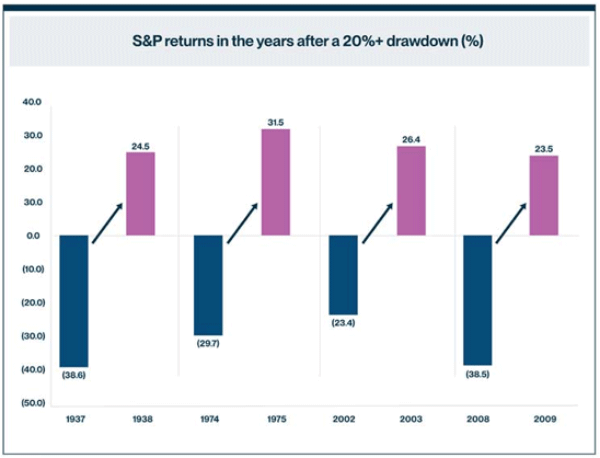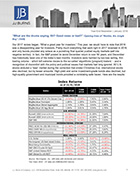“You damn right, I’ve got the blues / From my head down to my shoes” Buddy Guy, “Damn Right, I’ve Got The Blues”
Every investor is now aware that this is shaping up to be a difficult year for global-equity and -bond markets. The current pace for equities would result in the worst calendar-year returns for U.S. stocks since 2008 (-37% with dividends), and worse than any of the three negative years following the bursting of the Tech Bubble in 2000. Bonds are on track for their worst year in four decades (and possibly since the late 1700s), as well as their first back-to-back annual declines. Inflation is high around the globe, and though a number of factors are pushing prices higher, one major contributor is the Ukraine war food- and energy-chain supply disruptions and the resultant politics surrounding them. The major ‘weapon’ central banks have unleashed to combat high inflation is interest-rate increases, which have had a chilling effect on equity and bond markets. If it wasn’t clear, the U.S. Fed sets the mood and spikes the punch at parties (i.e., lowers rates) and takes the punchbowl away much later in the festivities (i.e., raises rates). It should also be clear that debt financing and interest rates are what investors should focus on as indicators of economic health. A summary of results follows:

“I get knocked down, but I get up again / You’re never gonna keep me down” Chumbawamba, “Tubthumping”
Investors and policymakers (including the Fed) are focused on data right now, hoping to divine signs from various trends and datapoints that point to directions in prices, employment, growth and elections. Rather than revisit data we’ve recently discussed, we’ll emphasize that the environment offers the opportunity to focus on the future. Most investors in market downturns think defense: sell stocks, buy bonds, hold high cash balances and delay financial decisions until things ‘look good’ again. The ‘good’ signs usually are an end to a recession highlighted by falling unemployment, positive GDP growth, rising stock markets and falling interest rates. We see current sentiment pointing to a near-term pullback, and echo the sentiments of a market pundit who advises investors to “look for things to be getting better” rather than a specific inflection point or a ‘good’ environment (usually a sharp rebound in stock prices) to invest. This translates to having a rebound mindset now, and we think much (though not all) of the market pain is behind us. We also know timing markets is a risky endeavor at best, so we offer an example of why being prepared to go on offense is the best strategy for long-term planning:

This chart demonstrates the returns of the S&P price index in the year following a 20% or greater loss. Stocks tend to be a leading indicator, so the rebounds shown above also indicate some revitalization in the datapoints we mentioned earlier. Please note that this is NOT a prediction on next year’s market returns, but is an illustration of past results at times of extreme inflections and pessimism. The markets are currently pricing in higher unemployment and interest rates, inflation, lower earnings, and a recession. We think these issues facing the global economy, while serious, are fixable.
Take a look at the ‘two markets’ of 2009 in more detail:

We can see a tale of two markets in one year, the winter bear and the resounding bull. An accounting-change trigger on March 9 of 2009 spurred markets to roar back for the rest of the year. Sideline investors thinking the March and April results were head feints missed the beginning of the long recovery rally. Again, this is not a prediction, but an illustration of the benefit of staying in the game.
“This is the craziest party / That could ever be / Don’t turn on the lights / ‘Cause I don’t wanna see” Three Dog Night, “Mama Told Me (Not to Come)”
In a normal economic correction, quality bond yields are flat or slightly up, acting as a pressure-relief valve for investors in classic 60/40 portfolios. The general strategy is for investors to sell bonds (usually high-quality government and corporate issues) and buy stocks when prices fall. That has not been an effective strategy in this environment, as global central banks have kept short-term rates low and bought bonds in the market since the Financial Crisis to help reflate asset prices. This policy has been extremely effective, as stocks soared in the past decade and investors and bond-issuers enjoyed low financing costs to the detriment of savers.
Central banks are now scrambling to make up for lost time by trying to quickly cool the global economy and tame inflation without causing recession(s), the ‘soft landing’ referred to in the media. This is a difficult task in the best of times, and is now made more so as rates and inflation have been low for so long. Consumers, states and municipalities and corporations flush with cash exacerbated the situation, and the Fed in particular is raising rates aggressively (five hikes this year totaling 3.00% with three of 0.75%) to cool the economy and spending. This has affected housing and stock prices, but has not yet dampened inflation or caused substantial job losses, so there’s a ways to go for real economic pain to set in. These hikes are the most aggressive hikes (three consecutive at 0.75%) since 1994. The benchmark U.S. 10-year Treasury started 2022 at 1.52% and recently topped 4.00%, the highest level in a decade. The Fed really controls rates in short-maturity paper, so the UST 10 reflects the market’s less-than-sanguine expectations about growth, inflation, and recession.
As optimists, we must note there is a silver lining to this somber bond data. Since May of 2000, the Fed has lowered the Fed Funds rate 28 times. Excluding the two (2) reductions in 2020 due to COVID, the Fed has lowered 26 times in two decades. Here’s a summary of Fed rate decreases since 2000:

Over 60% of the changes are reductions of 0.50% or more. Here are two significant takeaways:
- The Fed acts aggressively in deteriorating economic environments and drops rates quickly.
- Investors with longer-maturity bonds will tend to do better than owners of cash or short-term bonds.
As troubling as things might seem now for stocks and bonds, there are reasons why each asset class is performing poorly, and each has a more robust path forward despite expected future volatility.
“People get ready, there’s a train a-comin’ / You don’t need no baggage, you just get on board” Curtis Mayfield and The Impressions, “People Get Ready”
These are unusual times for investors as the many pattens we’ve relied on in recent years are being re-shaped by a number of factors, the most harmful being the COVID pandemic. Answers and clear direction aren’t easy to come by, but staying engaged and in the game will definitely ease transitions and smooth bumpy markets. This implies that the best defense in this period is to prepare to play good offense when investors are back on the field. Staying engaged and getting prepared is a mental exercise, shedding negative tendencies generated by fear and doubt and taking small victories as they’re available. We’ve been actively managing cash balances, making portfolio adjustments, taking tax losses and preparing to rebalance accounts to get ready for our moment back in the game. These are defensive actions that will make for better outcomes when we reach the other side of the Great Recalibration.
As always, we welcome your comments, questions and feedback, and thank you for your trust in us.
—Your Wealth Management Team at JJ Burns & Company
Download Market Commentary
Disclosure: J.J. Burns & Company, LLC is a registered investment adviser with the U.S. Securities & Exchange Commission and maintains notice filings with the States of New York, Florida Pennsylvania, New Jersey, Connecticut, Georgia, Illinois, North Carolina, and California. J.J. Burns & Company, LLC only transacts business in states where it is properly registered, or excluded or exempted from registration. Follow-up and individualized responses to persons that involves either the effecting or attempting to effect transactions in securities, or the rendering of personalized investment advice for compensation, as the case may be, will not be made absent compliance with state investment adviser and investment adviser representative registration requirements, or an applicable exemption or exclusion.
All investing involves risk, including the potential for loss of principal. There is no guarantee that any investment plan or strategy will be successful.
The foregoing content reflects the opinions of J.J. Burns & Company, LLC and is subject to change at any time without notice. Content provided herein is for informational purposes only and should not be used or construed as investment advice or a recommendation regarding the purchase or sale of any security. There is no guarantee that the statements, opinions or forecasts provided herein will prove to be correct.
Past performance may not be indicative of future results. Indices are not available for direct investment. Any investor who attempts to mimic the performance of an index would incur fees and expenses which would reduce returns.
Securities investing involves risk, including the potential for loss of principal. There is no assurance that any investment plan or strategy will be successful.


